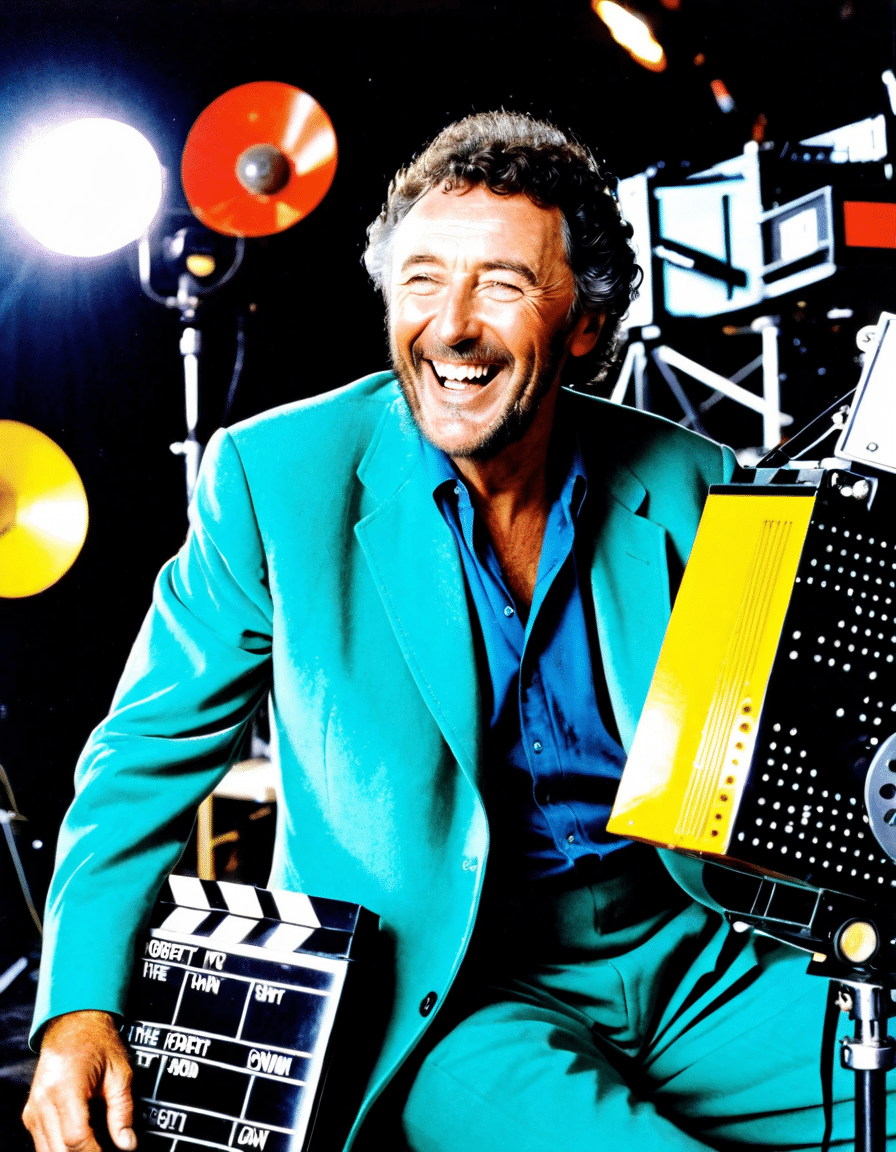Bud Dwyer wasn’t just another name in Pennsylvania politics; he was a beacon of hope for many. Born on November 21, 1930, Dwyer was a man fueled by ambition and passion. With a degree in political science, his political aspirations took flight as he worked tirelessly in the Pennsylvania House of Representatives before ultimately securing the position of state treasurer in 1981. His commitment to reform and transparency resonated with the public, marking him as a charismatic leader in the early stages of his career. Yet, few knew how quickly the tide could turn, impacting not just his life but the public’s perception of mental health in politics.

The Unfolding Scandal: Bud Dwyer’s Downfall
By the early 1980s, the once brightly shining star of Bud Dwyer began to dim, revealing the cracks beneath the polished surface. Accusations of corruption cast a long shadow over his earlier image of integrity. In 1986, he was indicted for allegedly accepting kickbacks related to a bidding process for state contracts, sending shockwaves through his community and beyond. The media sensationalized the accusations, morphing Dwyer from a beloved public servant to a figure of scandal and distrust.
With mounting pressure, the walls seemed to close in on Dwyer. Public opinion turned sharply against him, and the impending trial felt like an executioner’s blade hovering above a noose. He had built his career on trust, yet here he was, scrutinized as a corrupt politician. The stark contrast between his past ideals and his current situation was nothing short of a tragedy unfolding before a nation hungry for stories about failure and betrayal.

A Moment That Shocked the Nation: The Press Conference
On January 22, 1987, Bud Dwyer hosted a press conference meant to clear his name, but it morphed into one of the most haunting moments in television history. Cameras rolled as he began to speak, his words heavy with despair. Then, in a shocking twist that would forever etch his name into the annals of American tragedy, Dwyer pulled out a gun and took his own life live on air. This heart-wrenching act of desperation captivated the nation, sparking widespread conversations about mental health and the brutal pressures faced by public servants.
Television viewers were left stunned, grappling with what they had just witnessed. The image of a once-promising leader, overwhelmed by the crushing weight of scandal and public opinion, became a symbol of the deep-seated issues surrounding mental health in high-pressure environments. The shock waves rippling outwards demonstrated not just a personal tragedy, but a cataclysm of broader societal implications.
Analyzing the Aftermath: Media Coverage and Public Reaction
Following Dwyer’s suicide, the media circus kicked into high gear. Notably, the relentless broadcasting of the event raised ethical questions about the responsibility of news outlets. The replaying of his death became a topic of heated debates, with critics pointing out the lack of sensitivity towards mental health issues. Did sensationalist coverage merely exploit a man’s tragic end for viewership gains? Many viewers pushed back against this narrative, longing for compassion amidst the chaos.
Documentaries and news features following his death tackled the complex emotional landscape surrounding suicides, especially in the context of public figures. Bud Dwyer’s last moment on screen illuminated the raw, often ignored, pain of individuals within the spotlight. This led to an essential, albeit painful, national conversation about mental health, prompting many to reconsider their views on the struggles faced by public figures.
How Will Proctor Navigated His Legacy: A Focus on Mental Health Awareness
In the wake of Dwyer’s tragic legacy, advocates, such as Will Proctor, emerged to champion mental health awareness. Recognizing the ripples of Dwyer’s story, Proctor’s initiatives sought to brick-by-brick de-stigmatize conversations surrounding psychological struggles. This call to action catered to those residing in high-pressure environments, pushing for frameworks that encouraged open dialogue around mental health.
Through workshops and community outreach, Proctor aimed to provide support for individuals feeling the weight of similar pressures. His efforts represented a cultural shift towards cultivating greater understanding and respect for mental well-being, especially as it affects leaders in public service. Dwyer’s heartbreaking end became a rallying cry to prioritize mental health resources, inspiring activism that rippled far beyond the political sphere.
The Cultural Impact: How Bud Dwyer’s Story Transformed Entertainment and Media
Bud Dwyer’s story didn’t just end with his tragic end; it reverberated throughout popular culture, altering the landscape of media ethics and artistic expression. Films and music began to reference Dwyer’s life and death, illustrating the intersection of tragedy and art. Documentaries like Dwyer: America’s Tragedy dissected the truth behind his life, portraying the urgent need for empathy rather than sensationalism in storytelling.
Amid the turmoil, conversations about ethics within journalism surged forward. The responsibilities of the media have been scrutinized like never before, pushing for a narrative that honors the dignity of the individuals involved. Dwyer’s death served as a turning point in how tragedies are approached, urging content creators and journalists to examine their practices thoughtfully.
Reflecting on Dwyer’s Legacy: Lessons for Future Generations
The saga of Bud Dwyer serves not just as an old news story but as a blueprint for understanding the intersections of mental health, media, and public life. Future generations can find lessons embedded within his narrative—lessons about the importance of access to mental health resources, understanding the pressures faced by public figures, and the potential harm in sensationalism.
In the ages to come, it’s crucial to foster a compassionate societal mindset that embraces rather than ostracizes individuals struggling under pressure. Bud Dwyer’s tragic tale is not merely one of despair, but one of awareness. It haunts us yet urges us towards progress.
A Legacy Beyond Tragedy
See, the story of Bud Dwyer isn’t just unsettling; it’s profoundly significant. It compels us to confront uncomfortable truths about mental health, societal expectations, and the responsibilities of leaders and the media alike. His life and tragic end read like a cautionary tale—one that holds a mirror to our societal values. As we reflect on Dwyer’s legacy, we must ensure that the conversations sparked by his story strive for understanding, empathy, and support for those battling their own unseen wars, whether in the limelight or behind closed doors.
As we live in an era where discussions around mental health grow louder, let’s remember that the path paved by Bud Dwyer wasn’t just tragedy; it was a call to consciousness, inviting us to extend our hands to others before a despairing moment turns into an irreversible act.
Bud Dwyer: The Shocking Trivia Behind a Tragic Event
The Man Behind the Moment
Bud Dwyer was a prominent Pennsylvania politician whose career took a devastating turn during a shocking press conference on January 22, 1987. But there’s more to this man than just the tragic event that made headlines. Before his political career, Dwyer was known for his passion for sports and outdoor activities, something that many might not associate with a politician. His love for sports is somewhat akin to how fans appreciate a good el Gallo show, where emotion runs high and surprises are lurking around every corner. Speaking of unexpected twists, his life mirrors some plot twists found in shows today, evoking an intensity similar to the climactic moments in anime, just like those captured in a Naruto poster.
The Press Conference: A Shocking Reality
During the press conference that left viewers stunned, Bud Dwyer brandished a revolver and ultimately took his own life, an action that shocked the nation. This haunting moment has been dissected in various media, drawing parallels with other cultural phenomena where tension bubble over. Just as athletes like Dwight Howard highlight the pressures of performance on and off the court, Dwyer’s tragic end serves as a somber reminder of the psychological weight some public figures carry. In the wake of the incident, discussions surrounding mental health in high-pressure careers have become more pronounced, showcasing how society is beginning to take these issues more seriously, much like how brands, such as Jlo Beauty, have emerged to address self-image and wellness in an overtly scrutinizing environment.
Legacy and Reflection
Dwyer’s life story doesn’t end with his death. His tragic narrative prompted many to reflect on the moral obligation to support mental health initiatives and transparency. His name often resurfaces in discussions on media ethics and the responsibilities of journalists, much like how every new development in the lives of people like Christopher Candy draws public interest. The conversation surrounding his story continues to unfold, much like the evolving dialogue around figures like Floyd Trolls, who capture public attention for their controversial choices. Understanding the impact of Dwyer’s actions highlights an ongoing struggle against public scrutiny—something that’s as prevalent in celebrity culture as it is in politics, urging us to be kinder in an increasingly harsh world.
As we delve into this shocking chapter, the complexities of human emotions become undeniable. In a society where everyone battles their demons, Bud Dwyer’s story serves as a poignant reminder of the need for empathy—after all, we’re all just trying to find our footing, whether we’re watching the dramatic landscapes unfold in the Video Streaming age or following the rising careers of stars like Leo wu and beyond.

















